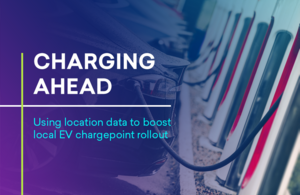Location data can help build the EV chargepoint network of tomorrow
New report sets out how location data can support local authorities to make good decisions about where EV chargepoints should be installed.

- New report seeks to support local authority decisions about electric vehicle (EV) chargepoint rollout
- The transition to EVs will be enabled by a dependable public charging network and local authorities are ideally placed to identify their local charging needs
- Location data can provide the evidence base needed to support better decisions about local charging infrastructure
By 2030, the sale of new petrol and diesel cars will be phased out and by 2035 all new cars and vans will be zero emission. The transition to EVs will be enabled by a dependable, well located public charging network that local authorities are ideally placed to help deliver.
Location data can arm local authorities with evidence to rollout a public charging network that gives current and prospective EV owners the confidence to make their journeys, whether in a densely populated city or the countryside. Drivers need to have the same confidence that they can charge their EV as they have that they can refuel their current petrol or diesel vehicle, so they can go about their business unimpeded. This is critical to the growth of the economy, one of the Prime Minister’s five priorities.
Viscount Camrose, Minister, Department for Science, Innovation and Technology, said:
The transition to electric vehicles is central to the government’s plan to decarbonise the transport sector, keep the UK at the forefront of clean transport and tackle pollution, all while seizing the potential for growth and job creation in the UK’s growing EV industry.
Local authorities and the wider sector should continue to embrace new location data and analysis to accelerate the targeted rollout of chargepoints so that drivers can find and access reliable chargepoints wherever they live.
The location of chargepoints is as important as absolute numbers. This report explores the breadth of location data and applications available to support local authority decisions about where to install new chargepoints and identifies five opportunities to better use existing location data, as well as new sources of information to:
- understand the location and availability of existing chargepoints by making chargepoint operator data standardised and consistent
- understand consumer charging behaviour and travel patterns by using population movement data
- identify the location of EVs by using commercially-held data about leased vehicles
- identify existing electricity network capacity through better use of distribution network operator data
- identify areas without off-street parking by using proxy data
Transport networks need to become more efficient, greener and safer. The Geospatial Commission has been leading a multi-year programme highlighting the opportunities for advanced geospatial applications in the transport sector. The programme has identified how location data can support the future of mobility and next generation transport networks and called out ways to maximise its impact. In 2021 we published ‘Getting to the Point’ which explored the role of location data to help model future demand for chargepoints, identify suitable sites, create a seamless consumer experience and track rollout.
This report highlights that the location of chargepoints is as important as absolute numbers. Consumers want chargepoints to be where they need them and for them to be easily accessible. Local authorities are ideally placed to identify local needs and play a fundamental role in facilitating private sector investment and ensuring all communities have access to reliable public charging infrastructure, especially on-street charging points. They must make informed decisions about how many, which types and where chargepoints will be installed, based on demand and site suitability. Location data and applications can give valuable insight.
Martin Tugwell, Chief Executive, Transport for the North, said:
High quality location data plays a critical role in enabling better decision making on how society can make a rapid transition to achieving a low carbon economy.
Location data and analysis is a vital component of our work at Transport for the North to underpin activities outlined in our regional Strategic Transport Plan, such as supporting our local authorities EV charging planning and delivery, and facilitating private sector investment to drive EV chargepoint rollout.
Steve Ward, Decarbonisation Programme Manager, Transport for Wales, said:
Good quality location data is essential to us helping the public and private sectors collaborate to identify and develop sites for electric vehicle charging. We have worked with datasets from a large number of sources to develop modelling tools that indicate which locations are more suitable for commercially-funded charging facilities, and which could be unlocked by targeting investment in improving electricity supply capacity.
We are sharing the outputs of our mapping with all stakeholders, including the electricity Distribution Network Operators, who are using this data to plan ahead of anticipated demand for charging ‘hotspots.
*[EV]; electric vehicle